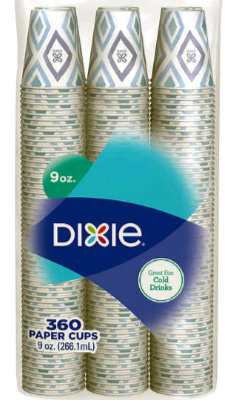 If something called a dixie existed, I have little doubt that we could refer to it differently without changing its aroma, but the word “dixie” doesn’t really identify anything. It is not, in other words, a common noun. As a proper noun — with a capital ‘D’ — it is used as both a surname and a given name and to identify a wide variety of things including a region of our country. People with a first, last, or nickname of Dixie surely outnumber things bearing the name but there are certainly plenty of those. It has been used to identify buildings, songs, currency, music groups, towns, counties, movies, beer, boats, ships, taverns, race tracks, waterways, restaurants, mountain ranges, athletic conferences, grocery stores, airports, schools, universities, and much more. With an ‘X’ made of a stylized flower, Dixie is a registered trademark of Georgia-Pacific for a brand of paper products.
If something called a dixie existed, I have little doubt that we could refer to it differently without changing its aroma, but the word “dixie” doesn’t really identify anything. It is not, in other words, a common noun. As a proper noun — with a capital ‘D’ — it is used as both a surname and a given name and to identify a wide variety of things including a region of our country. People with a first, last, or nickname of Dixie surely outnumber things bearing the name but there are certainly plenty of those. It has been used to identify buildings, songs, currency, music groups, towns, counties, movies, beer, boats, ships, taverns, race tracks, waterways, restaurants, mountain ranges, athletic conferences, grocery stores, airports, schools, universities, and much more. With an ‘X’ made of a stylized flower, Dixie is a registered trademark of Georgia-Pacific for a brand of paper products.

 In the 1960s, an all-girl singing group borrowed the name — without the flowery ‘X’ — of those familiar disposable cups and topped the charts with hits like “Chapel of Love” and “Iko Iko”. Near the end of the twentieth century, another all-girl group hit the charts with a name containing the word “dixie”. That group, the Dixie Chicks, generated some controversy, but it came from political statements and not from their name. I’m not aware of any controversy at all associated with the Dixie Cups, and I’m guessing that they didn’t consider the word “dixie” to be racist.
In the 1960s, an all-girl singing group borrowed the name — without the flowery ‘X’ — of those familiar disposable cups and topped the charts with hits like “Chapel of Love” and “Iko Iko”. Near the end of the twentieth century, another all-girl group hit the charts with a name containing the word “dixie”. That group, the Dixie Chicks, generated some controversy, but it came from political statements and not from their name. I’m not aware of any controversy at all associated with the Dixie Cups, and I’m guessing that they didn’t consider the word “dixie” to be racist.
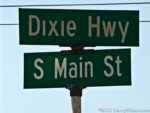 But recently the word has been associated with racism by some. The Dixie Highway has been included in some of these claims which naturally caused me to take notice. It is an outgrowth of the rise of controversy and confrontation over Confederate monuments and streets named after Confederate generals. If the move to change a roughly six-mile-long street from Hood to Hope was complicated, renaming a piece of the nearly 6,000-mile-long Dixie Highway must be at least three orders of magnitude more so.
But recently the word has been associated with racism by some. The Dixie Highway has been included in some of these claims which naturally caused me to take notice. It is an outgrowth of the rise of controversy and confrontation over Confederate monuments and streets named after Confederate generals. If the move to change a roughly six-mile-long street from Hood to Hope was complicated, renaming a piece of the nearly 6,000-mile-long Dixie Highway must be at least three orders of magnitude more so.
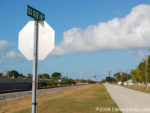 The aforementioned Hood Street was in Hollywood, FL, where three streets (Hood, Lee, and Forest) were renamed (Hope, Liberty, and Freedom) in November 2017. In Riviera Beach, FL, a couple of miles of Old Dixie Highway were renamed President Barack Obama Highway in 2015. The picture at left was taken between the two, near Boyton Beach. Of course, the word “dixie” had nothing to do with the renamings in Hollywood. The generals after which the streets were named had clearly been chosen because of their roles in the Confederacy. The word didn’t have much to do with the name change in Riviera Beach, either. Residents cited the role of the street as a dividing line between black and white and the site of KKK cross burnings.
The aforementioned Hood Street was in Hollywood, FL, where three streets (Hood, Lee, and Forest) were renamed (Hope, Liberty, and Freedom) in November 2017. In Riviera Beach, FL, a couple of miles of Old Dixie Highway were renamed President Barack Obama Highway in 2015. The picture at left was taken between the two, near Boyton Beach. Of course, the word “dixie” had nothing to do with the renamings in Hollywood. The generals after which the streets were named had clearly been chosen because of their roles in the Confederacy. The word didn’t have much to do with the name change in Riviera Beach, either. Residents cited the role of the street as a dividing line between black and white and the site of KKK cross burnings.
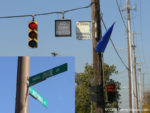 Although I’d have preferred it hadn’t happened, I have no serious objection to the Riviera Beach action. It was based on specific and painful memories. That doesn’t always appear to be the case when replacing the Dixie Highway name is proposed. Published reports of these proposals have occasionally prompted me to send emails to people connected with them. It is not done to protest but to inform. We road fans often comment — and sometimes laugh or cry — about people being completely oblivious to a major historic highway running right by their door. Knowing how common that is with “celebrities” like the Lincoln Highway and Route 66, we shouldn’t be surprised that it is even more often the case with the lesser known and more complex Dixie Highway. Not knowing just how important or far-reaching all the roads in your neighborhood once were is a pretty natural situation.
Although I’d have preferred it hadn’t happened, I have no serious objection to the Riviera Beach action. It was based on specific and painful memories. That doesn’t always appear to be the case when replacing the Dixie Highway name is proposed. Published reports of these proposals have occasionally prompted me to send emails to people connected with them. It is not done to protest but to inform. We road fans often comment — and sometimes laugh or cry — about people being completely oblivious to a major historic highway running right by their door. Knowing how common that is with “celebrities” like the Lincoln Highway and Route 66, we shouldn’t be surprised that it is even more often the case with the lesser known and more complex Dixie Highway. Not knowing just how important or far-reaching all the roads in your neighborhood once were is a pretty natural situation.
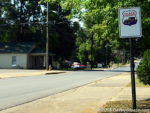 It seems that even we fans don’t always consider that “far-reaching” bit. It’s OK to be saddened by a name change, but there is no reason to verbally abuse, as I’ve seen too many times, those backing a change. Removing the name Dixie Highway from a few miles of Florida — or other — roadway is not going to affect all those other miles any more than Cheyenne, WY, (The first town to do so.) changing its Main Street to Lincoln Way impacted the rest of the continent crossing highway. The Dixie Highway, as well as every other named auto trail, was never labeled with its name in every jurisdiction it passed through. Numbered US and state highways utilize streets and roads with all sorts of names. Not one inch of US-66 officially exists at present yet people follow it every day. The Adairsville, GA, pavement in the picture at left is officially named and signed Main Street but that doesn’t change its past as a part of the Dixie Highway or prevent it being unofficially marked as such.
It seems that even we fans don’t always consider that “far-reaching” bit. It’s OK to be saddened by a name change, but there is no reason to verbally abuse, as I’ve seen too many times, those backing a change. Removing the name Dixie Highway from a few miles of Florida — or other — roadway is not going to affect all those other miles any more than Cheyenne, WY, (The first town to do so.) changing its Main Street to Lincoln Way impacted the rest of the continent crossing highway. The Dixie Highway, as well as every other named auto trail, was never labeled with its name in every jurisdiction it passed through. Numbered US and state highways utilize streets and roads with all sorts of names. Not one inch of US-66 officially exists at present yet people follow it every day. The Adairsville, GA, pavement in the picture at left is officially named and signed Main Street but that doesn’t change its past as a part of the Dixie Highway or prevent it being unofficially marked as such.
 Most of the talk about renaming sections of the Dixie Highway has originated in Florida. In some sense, that’s ironic since the Dixie Highway was a major factor in the development of the state. On the other hand, development is rarely 100% beneficial to all and I’ve no doubt that many were negatively impacted by the development and the road that helped it along. Plus, as those Riviera Beach memories show, experiences generate stronger feelings than a name or a physical path ever could. About two weeks ago, the New York Times published an article based on discussions in Florida’s Miami-Dade County. Its audience was almost certainly wider than that of similar articles publishes by Florida based news organizations. One indication of that was a small but obvious two-day blip in visits to an eight-year-old Dixie Highway related post on this blog. Maybe that’s somehow fitting since I’ve often quoted the Times when trying to convey that the Dixie Highway is not inherently evil. In 1915, the paper referred to the route as “The Dixie Peaceway” when it reported the formation of the Dixie Highway Association. It described the road as “a monument to celebrate the half-century of peace within the Union”. Maybe that was hyperbole or maybe it really reflected the feelings of the time. If so, it seems extra sad that so many see it as something entirely different today.
Most of the talk about renaming sections of the Dixie Highway has originated in Florida. In some sense, that’s ironic since the Dixie Highway was a major factor in the development of the state. On the other hand, development is rarely 100% beneficial to all and I’ve no doubt that many were negatively impacted by the development and the road that helped it along. Plus, as those Riviera Beach memories show, experiences generate stronger feelings than a name or a physical path ever could. About two weeks ago, the New York Times published an article based on discussions in Florida’s Miami-Dade County. Its audience was almost certainly wider than that of similar articles publishes by Florida based news organizations. One indication of that was a small but obvious two-day blip in visits to an eight-year-old Dixie Highway related post on this blog. Maybe that’s somehow fitting since I’ve often quoted the Times when trying to convey that the Dixie Highway is not inherently evil. In 1915, the paper referred to the route as “The Dixie Peaceway” when it reported the formation of the Dixie Highway Association. It described the road as “a monument to celebrate the half-century of peace within the Union”. Maybe that was hyperbole or maybe it really reflected the feelings of the time. If so, it seems extra sad that so many see it as something entirely different today.
Those people who found this site after reading the New York Times article didn’t learn a whole lot during their visit but they were obviously curious. They were brought by search engines which may have also taken them to other sites where they learned much more. Whether curiosity was their only reason for visiting or they were decision-makers gathering background, I’ll never know. Regardless, I suspect we will see a few more miles of Dixie Highway get renamed before it’s all over. That’s unfortunate but hardly a disaster. No matter the name, it will still smell like a rose — or maybe an orange blossom — with strong undertones of asphalt and Model T brake bands.
ADDENDUM 9-Feb-2020: Some thoughts on the markers placed along the Dixie Highway by the United Daughters of the Confederacy were considered for this post but have been given their own post instead. Free? Advertising on the Dixie
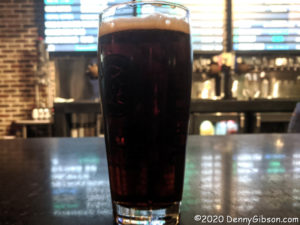 I attended my first Bockfest Parade in 2010 and immediately regretted missing the preceding seventeen. My attendance hasn’t been perfect since then but it’s on the plus side: 6 of 10. My attendance at other Bockfest events has been perfect. I haven’t attended a single one and that includes the multiple Sausage Queen competitions that take place each year. One reason was the expectation of crowded spaces which I don’t enjoy nearly as much as I once did but location has also been a factor. To be honest, location could be problematic for a couple of reasons. One, of course, was distance. Most events happen downtown which means a bit of a drive plus dealing with parking. Secondly, many were in places I was unfamiliar with. I presumed that most of the attendees were folks who frequented the various places and the fact that I did not sort of added to the “crowded spaces” aspect. But this year the last of seven qualifying events took place just up the road in a place I’m fairly familiar with.
I attended my first Bockfest Parade in 2010 and immediately regretted missing the preceding seventeen. My attendance hasn’t been perfect since then but it’s on the plus side: 6 of 10. My attendance at other Bockfest events has been perfect. I haven’t attended a single one and that includes the multiple Sausage Queen competitions that take place each year. One reason was the expectation of crowded spaces which I don’t enjoy nearly as much as I once did but location has also been a factor. To be honest, location could be problematic for a couple of reasons. One, of course, was distance. Most events happen downtown which means a bit of a drive plus dealing with parking. Secondly, many were in places I was unfamiliar with. I presumed that most of the attendees were folks who frequented the various places and the fact that I did not sort of added to the “crowded spaces” aspect. But this year the last of seven qualifying events took place just up the road in a place I’m fairly familiar with.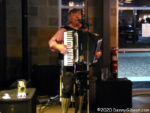 Sonder Brewing is the brewery closest to my home. It’s less than two crow-miles from my door and about two and a half if I stick to the roads. I arrived more than an hour ahead of the scheduled start of competition and the place was packed. I got a beer and hovered near the bar until a seat miraculously opened. My first beer was a porter. The second was the more appropriate William Goat bock pictured above. I can’t say whether or not the flouting of the “‑ator” bock naming convention was intentional but I can say it was quite good. I happily sipped my brew to the sounds of 99 Luftballon and Beer Barrel Polka — both in German. Then it was La Bamba and Livin’ On A Prayer in Spanish and English respectively.
Sonder Brewing is the brewery closest to my home. It’s less than two crow-miles from my door and about two and a half if I stick to the roads. I arrived more than an hour ahead of the scheduled start of competition and the place was packed. I got a beer and hovered near the bar until a seat miraculously opened. My first beer was a porter. The second was the more appropriate William Goat bock pictured above. I can’t say whether or not the flouting of the “‑ator” bock naming convention was intentional but I can say it was quite good. I happily sipped my brew to the sounds of 99 Luftballon and Beer Barrel Polka — both in German. Then it was La Bamba and Livin’ On A Prayer in Spanish and English respectively.
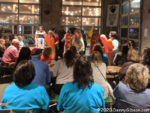 The competition took place in the far corner. The acoustics were horrible so I had almost no idea of what was going on and the lighting and distance helped me make photos that matched the acoustics. I got no pictures of one of the three entrants and didn’t even learn her name. I was rooting for Ashli, who was assisted by an energetic dance team, only because I’d met her and some of her team before things got rolling. Rhonda also had a little help and both had sizable cheering sections.
The competition took place in the far corner. The acoustics were horrible so I had almost no idea of what was going on and the lighting and distance helped me make photos that matched the acoustics. I got no pictures of one of the three entrants and didn’t even learn her name. I was rooting for Ashli, who was assisted by an energetic dance team, only because I’d met her and some of her team before things got rolling. Rhonda also had a little help and both had sizable cheering sections.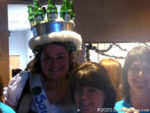 Rhonda was the ultimate winner although I don’t know why or how. She will represent Sonder Brewing in the final competition for the 2020 Sausage Queen at Bockfest Hall next Saturday.
Rhonda was the ultimate winner although I don’t know why or how. She will represent Sonder Brewing in the final competition for the 2020 Sausage Queen at Bockfest Hall next Saturday.
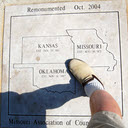
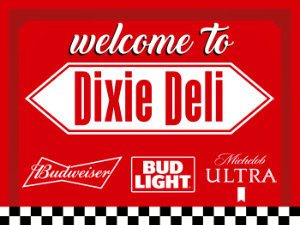 Seeing things like signs, banners, and menus for local businesses bearing the logo of some large corporation is quite common. Details vary but the basic model is that the big corporation shoulders some or all of the cost and the small business gets some advertising for little or nothing. The idea is hardly new and the concept has never been restricted to purely commercial enterprises. During the last half of the 1920s, a pairing of this sort existed between a major highway and an American hereditary association. The major highway was, of course, the Dixie Highway. The hereditary association was the
Seeing things like signs, banners, and menus for local businesses bearing the logo of some large corporation is quite common. Details vary but the basic model is that the big corporation shoulders some or all of the cost and the small business gets some advertising for little or nothing. The idea is hardly new and the concept has never been restricted to purely commercial enterprises. During the last half of the 1920s, a pairing of this sort existed between a major highway and an American hereditary association. The major highway was, of course, the Dixie Highway. The hereditary association was the  The UDC was the “advertiser” in this instance. Between 1926 and 1935 the organization was responsible for at least ten plaques being erected beside the highway. It’s unclear whether or not the Dixie Highway Association was an active participant in this arrangement. Because the 1926 creation of the United States Numbered Highway System brought an end to all of the named auto trails, the DHA was not very active at this point.
The UDC was the “advertiser” in this instance. Between 1926 and 1935 the organization was responsible for at least ten plaques being erected beside the highway. It’s unclear whether or not the Dixie Highway Association was an active participant in this arrangement. Because the 1926 creation of the United States Numbered Highway System brought an end to all of the named auto trails, the DHA was not very active at this point. Combined, the previous picture and the one at right show the ten plaques in north to south sequence. The northernmost marker is in Ohio, the southernmost is in Florida, the one preceding it is in South Carolina, and the others are in North Carolina. Except for the date erected, eight of the plaques are identical. The one in Florida contains the same text as those eight but has a different image of Lee. The one in South Carolina contains different text but has the same image as the bulk of the plaques.
Combined, the previous picture and the one at right show the ten plaques in north to south sequence. The northernmost marker is in Ohio, the southernmost is in Florida, the one preceding it is in South Carolina, and the others are in North Carolina. Except for the date erected, eight of the plaques are identical. The one in Florida contains the same text as those eight but has a different image of Lee. The one in South Carolina contains different text but has the same image as the bulk of the plaques.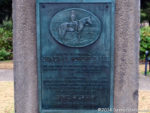

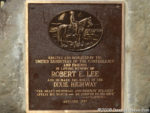
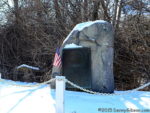
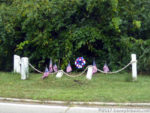
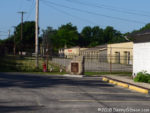
 If something called a dixie existed, I have little doubt that we could refer to it differently without changing its aroma, but the word “dixie” doesn’t really identify anything. It is not, in other words, a common noun. As a proper noun — with a capital ‘D’ — it is used as both a surname and a given name and to identify a wide variety of things including a region of our country. People with a first, last, or nickname of Dixie surely outnumber things bearing the name but there are certainly plenty of those. It has been used to identify buildings, songs, currency, music groups, towns, counties, movies, beer, boats, ships, taverns, race tracks, waterways, restaurants, mountain ranges, athletic conferences, grocery stores, airports, schools, universities, and much more. With an ‘X’ made of a stylized flower, Dixie is a registered trademark of Georgia-Pacific for a brand of paper products.
If something called a dixie existed, I have little doubt that we could refer to it differently without changing its aroma, but the word “dixie” doesn’t really identify anything. It is not, in other words, a common noun. As a proper noun — with a capital ‘D’ — it is used as both a surname and a given name and to identify a wide variety of things including a region of our country. People with a first, last, or nickname of Dixie surely outnumber things bearing the name but there are certainly plenty of those. It has been used to identify buildings, songs, currency, music groups, towns, counties, movies, beer, boats, ships, taverns, race tracks, waterways, restaurants, mountain ranges, athletic conferences, grocery stores, airports, schools, universities, and much more. With an ‘X’ made of a stylized flower, Dixie is a registered trademark of Georgia-Pacific for a brand of paper products.





